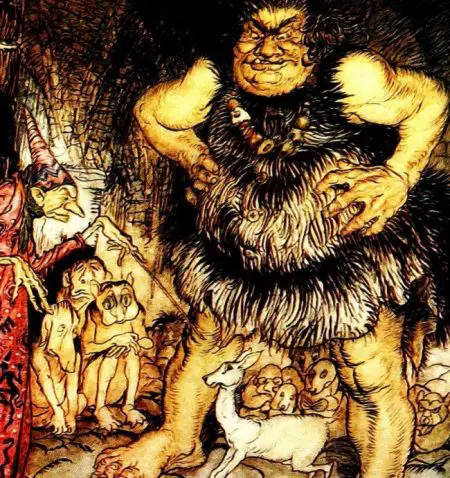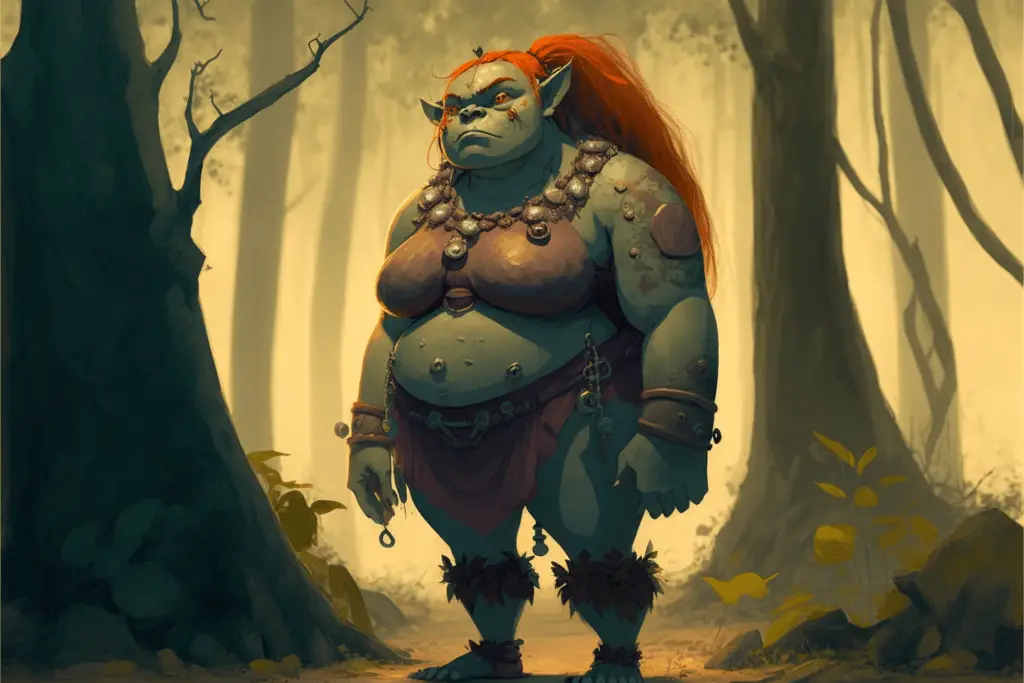Share the Lore!
By: Andrej Jovanovski
The Child-Eating Monster
Large and hideous, the ogres have been depicted as child-eating monsters that appear in folklore all around the world.
Although, having enormous strength, the ogres have been known for not being intelligent.
They have been depicted as inhumanly large, usually standing around 7 to 8 feet tall, having a disproportionately large head, and in some cases two heads.
Because of this, the ogres have been closely linked with giants in human cannibals in many mythologies, sometimes even been described as the offsprings of humans and giants.

Ogres as Metaphor Rather than Species
As ogres appear in literature their appearance varies, however, a common theme when it comes to the ogres is that the name in itself is often used as a trait of the character’s personality.
For example, the witch from Hansel and Gretel is considered a witch because of her intent to eat the children. The wolf from Little Red Riding Hood has also been said to resemble an ogre.
If we look into these “ogres” we can easily see that they try to outsmart the protagonists of the stories, which is something modern ogres are incapable of doing.
With this, we can see that the term ogre, throughout history, used to refer to the intent of eating children rather than a distinct species.
However, the recent portrayal of ogres in pop culture, slowly shifted away from this concept, embracing the traditional ogres, as their own species that rely on brute force rather than their intellect.
Yet this metaphor is still alive today, as it’s common for someone to use ogre as an insult, which insults one’s intellect.
Where the Ogres Slumber
We’ve all heard of the friendly swamp-ogre called Shrek, to some he’s the first ogre that they’ve come across, yet Shrek is nothing like his brethren so to consider him a true ogre should be wrong.
Yet, one thing is for certain, although being a friendly ogre we all know that he lives in a swamp.
This isn’t far off the mark when it comes to where ogres reside.
They can be found in woodland areas, such as forests, caves, and high mountain peaks, and yes they even live in swamps.
Because they mostly live in uninhabited areas, it is often thought that the children they eat are those who wander off on their own in the woods, but sadly this is not the case.
There have been many stories and tales where ogres attack castles and villages in search of humans. Terrorizing the commonfolk for ages, demanding children in order for the other villagers to be saved.
Like trolls, ogres can also be found under bridges, however, this is nothing more than just a temporary spot for them while they are in a city or village.

Diet of an Ogre
It’s evident that the main course for any ogre is humans, mostly children, this does not mean that that’s all they eat!
Living in the woods, the ogres are hunters that eat anything they can find, be it slugs, snakes, fish, to even bears and game. Yet, they only hunt other animals only when they are hungry, the same can rarely be said about hunting humans.
With this being said, it’s important to note that it’s never a good idea to interrupt an ogre when it is hunting!
Ogres in Pop-Culture
As it is with all mythological creatures, the ogres slowly made their way into the realm of entertainment.
Being so frequently used throughout European literature, it’s really hard to pinpoint when and where exactly they first appeared when it came to popular culture.
However, they can be found throughout many fantasy-based worlds, appearing in countless video games and movies.
And although the depictions of ogres vary, two traits are always present, their sheer size and different colored skin.

As previously mentioned, one of the most famous ogres is our green-skinned gentle giant Shrek and his human-turned-ogre wife Fiona. Being anything but ogre-like when it comes to their personality, these two are often considered to be one of the only kind-hearted ogres.
Another famous, or in this case infamous, ogre is Cho’Gall who is an ogre with two heads, one called Cho and the other, well, Gall.
He was a powerful mage, apprentice to the most powerful warlock in the Warcraft universe, Gul’dan.
As is the case with most fantasy universes, Warcraft is the home to ogre clans and species, where they are shown to be dim-witted relying on their strength. It’s worth noting that there are a lot of ogres that practice magic in this universe.
In Dungeons & Dragons, ogres are a race that are notorious for their quick temper. When enraged, they are capable of destroying structures just by running into them.
Although not called ogres, the five Super mutants from Fall Out 3, are shown to resemble ogres, as they are cannibalistic, brutish, dimwitted, and short-tempered.

Misconceptions About Ogres
As previously mentioned, it is because of Shrek a lot of people mistake ogres for kind creatures, often forgetting what they are capable of and how brutish they are.
This is one of the biggest mistakes someone can make, as it has often resulted in death.
Another misconception is that someone can reason with an ogre, not realizing that their below-the-average intellect makes them behave like spoiled children, often trying to sort out their problems through violence.
Although lacking intellect, it is not easy to simply outsmart an ogre, because their brute strength allows them to go through a lot of obstacles without the need of thinking for a solution. It is better to make a plan on how to deal with an ogre, rather than trying to think of something in the heat of the moment.
With all of this in mind, it is important to remember that the best way to deal with an ogre is simply to try to run away and hide because without a plan we cannot defeat or even deal with these child-eating brutes!
References:
Ogre, Britannica, https://www.britannica.com/topic/ogre , Accessed 20th September 2021 Where do Ogres Live? https://www.wonderopolis.org/wonder/where-do-ogres-live , Accessed 21st September 2021 Dean Thompson, The Truth about Mountain Ogres, Talk for Writing, 2021
